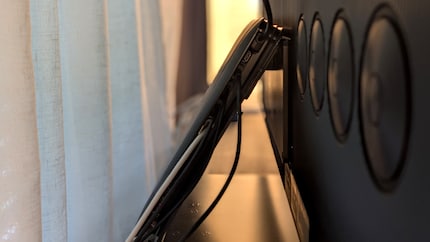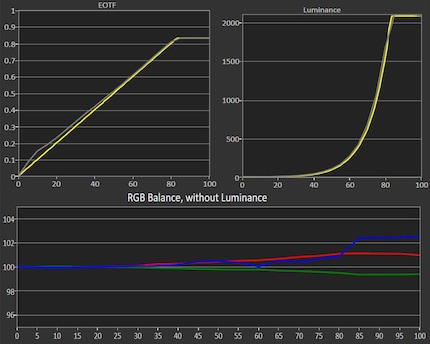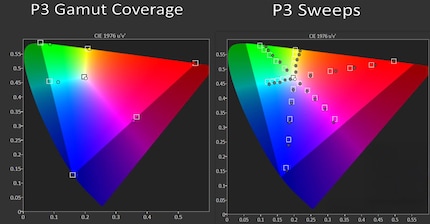
Product test
Samsung S95D test: the best OLED TV for bright rooms
by Luca Fontana

It looks like the old one, but under the bonnet Samsung has done some serious tweaking: the S95F is brighter, sharper, better - and even gives HDR titans like LG's G5 a run for their money.
Full Disclosure: The TV, the 65-inch version of the S95F, was provided to me by Samsung for testing. However, Samsung has no influence on the test result, my evaluation and the test procedure.
Three years ago, Samsung made its OLED comeback with the S95B. But instead of relying on classic WOLEDs like LG, Samsung opted for its own technology: QD-OLED. The quantum dot layer ensured particularly pure colours and a colour accuracy that made even calibrated home cinema enthusiasts nod their heads.
Last year, an anti-reflective layer followed, which eliminated reflections so effectively that Samsung's OLEDs suddenly became competitive even in bright rooms. Now the S95F is the fourth QD OLED generation in the living room. And it's having a hard time. Because what do you do when the design remains, the reflections are gone anyway and even hardcore nerds can hardly complain anymore?
Samsung's answer: Increase the brightness. And the frame rate. And the computing power. The S95F wants to make everything a little better, but not reinvent anything. Sounds boring? Perhaps. But that's exactly the next step towards an all-round sophisticated QD OLED TV.
Samsung remains true to its slim «Infinity One» design - without frills, but with style. A slim aluminium frame at the front, discreet plastic at the back, done. The TV is so slim that it can be easily mounted on a wall. However, you will need a VESA 400×300mm bracket, which is not included. You can find this in our shop.

The overall package also includes the One Connect Box, which is standard on Samsung's top models - the small box that replaces the connections built into the panel. Just a single, inconspicuous cable connects the box to the TV and supplies power as well as video and audio signals. This gives you the option of elegantly concealing the box and all the cable clutter in a drawer of your TV furniture.
If you don't want or need this, the One Connect Box can also be easily attached to the stand.

About the specs. Samsung's S95F offers the following:
All four HDMI inputs support HLG, HDR10 and HDR10+. Dolby Vision, however, is still missing. Unfortunately. This is unlikely to change in the future. Charlie Chulho Bae, Head of TV and Sound Product Management in Europe, explained to me at the beginning of the year: «We don't adopt existing standards - we prefer to develop our own technologies.»
In addition, Netflix (and possibly others) want to offer more HDR10+ content soon anyway.
The S95F is capable of Dolby Atmos, including pass-through, if you forward the sound to an external sound system. DTS audio formats, on the other hand, are neither supported by the built-in speakers nor channelled through from the TV. Instead, they are reproduced and passed on as lower-quality multichannel PCM 5.1 audio.
What comes next goes deep into the subject matter. I measure with professional tools from Portrait Display to get an objective categorisation of the image quality. If you are not interested in details and diagrams, you can scroll to the chapter «The image: Precision with Punch».
About the measurements. I measured all screen modes of the TV without calibrating it - just as the device comes out of the box. I only made a few changes to the settings:
As in the previous year, the Filmmaker mode achieved the best measured values for all types of content. Except for gaming, for which you should always use gaming mode due to the input lag.
The Samsung S95F raises the bar even higher in my test lab: 2095 nits in the ten per cent window, even 2110 nits at two per cent - these are absolute top values and mark the second brightest OLED TV I have ever tested. This means that the S95F outperforms its direct predecessor, the S95D (1627 nits), but only just falls short of LG's new G5 (2350 nits), which has taken over the brightness sceptre with its tandem technology.
In comparison, the Philips OLED 809 is almost shockingly restrained at 906 nits - which is perfectly okay for the mid-range, but doesn't even come close to playing in the same league.
Samsung remains strong even with larger screens. In full screen (100 per cent white screen), the S95F achieves 385 nits - a value that is actually slightly above the G5 (380 nits) and far above last year's S95D (292 nits). Samsung has tweaked the peak brightness considerably and, together with LG, cuts a - watch out - dazzling figure.
Samsung remains true to its claim with the S95F: vivid colours, high colour precision - and all this straight from the factory. The grayscale measurement shows that the grey levels are very well graded over long distances. The EOTF curve follows the standard almost perfectly. There are only minor deviations from around 90 per cent brightness: The picture is slightly too bright here. Probably a deliberate trick to give HDR peak content more visual «punch».
The RGB balance also shows that everything is in the green zone - in the truest sense of the word. Between 10 and 80 per cent brightness, the balance of primary colours remains stable, with only a minimal excess of blue and red and a slight minus of green. From 85 per cent, the ratio tips: blue increases and green visibly decreases. The result is a rather cooler white in very bright image areas. However, this is only visible with a trained eye.

The average DeltaE value remains within limits at under 3, but at the brightest levels it just scratches the» five mark permitted for top televisions «. In everyday life, this means: very good colour fidelity for mere mortals, with some room for improvement for perfectionists.
I measure the coverage of the colour spaces:

The QD OLED delivers again this time. As with its predecessor, the S95F covers DCI-P3 almost completely, while BT.2020 is just over 90 per cent - LG's current WOLEDs can't achieve this, only QD OLED panels from Samsung's factories. In short: colours not only look rich, but also clean.
As with its predecessor, the S95F also uses a matt anti-reflective coating - once again confirming Samsung's supremacy in this discipline. The TV really comes into its own in daylight: Incoming light is not reflected, but scattered widely. Instead of dazzling at certain points, the ambient light is distributed so evenly across the screen that it is barely noticeable as a reflection.
The image then remains clearly recognisable, even in very dark scenes (below: «Blade Runner 2049») with a window in the back or a direct light source in the room.
Of course, there is a downside. In very bright environments, the black levels lose some of their perfect punch. Black then looks rather matt. But to be honest: what good is a theoretically perfect black level during the day if half of my window front is reflected in the picture?
In a dark room, this cancels out - then the S95F delivers classic OLED black, rich in contrast and precise. So you only make the trade-off with the matt black if the room is very bright. A clever compromise that I miss every time I test a different TV.
The picture on the S95F is impressively bright for an OLED TV and is already pleasantly colour accurate from the factory - so much for the theory. But how does Samsung's new QD OLED flagship perform in practice?
Time for a direct comparison. In addition to the S95F, I also tested its predecessor, the S95D, and LG's current top model, the OLED G5, under the same conditions. Three high-end televisions, two different OLED technologies - one with Quantum Dots, one with Tandem OLED. Who delivers the better picture?
If you would like to read the detailed individual tests of the two models, you can find them here:
How do the three top OLEDs differ in terms of colour rendering? I put them to the test with scenes from «Guardians of the Galaxy Vol. 2», «Avatar: The Way of Water» and «James Bond: Skyfall» - all of them visual heavyweights with strong colours, fine lighting moods and sophisticated skin tones.
Quelle: Disney+, «Guardians of the Galaxy Vol. 2» / «Avatar: The Way of Water», Apple TV+, «James Bond: Skyfall»
The S95F impresses straight away. It looks like a successful further development of the S95D - with slightly more colour depth, slightly richer tones and yet a high level of naturalness. The colours pop without being loud. HDR content in particular benefits from this. LG's G5, on the other hand, clearly focuses on emotion: warmer, more conciliatory, with emphasised skin tones and rich green. This is particularly effective for atmospheric films. Technically perhaps not quite as precise, but visually extremely pleasing.
The older S95D remains the most sober of the trio - cooler tuned, very precise and almost documentary-like restraint. If you are looking for maximum reference proximity, this is the right choice. This is also confirmed by my measurements (see above). However, the difference is so small that it is hardly noticeable in practice.
Which is better? A matter of taste. Or, as with three very good wines: it depends on what's in the glass next to it. Subjectively, however, I like LG's G5 the best.
How well do the top OLEDs perform in particularly dark or extremely bright film scenes? I tested them with «Blade Runner 2049» and «Jurassic World» - both films that push shadows, highlights and contrast gradients to their limits.
Quelle: UHD-Blu-Ray, «Blade Runner 2049» / «Jurassic World»
The S95F masters both disciplines with impressive precision. In dark images, even the finest shadow structures remain recognisable without the black level losing any of its depth. No noticeable black crush, no artificial brightening - simply a clean, deep picture with fine detail. It also impresses with highlights: light sources remain clearly delineated, colour gradients clean, no burn-out.
The LG G5 appears slightly more atmospheric in blacks: dark areas are even richer, but slightly less well defined. On the other hand, it shines in large areas of brightness: sunlight, explosions, the sky - everything looks bright and vivid. However, it lacks a little bit of differentiation in very selective highlights.
The S95D plays in the same league as its two successors, but is slightly more restrained. The shadow detail remains very good, but not quite as fine. And in bright scenes, the picture appears somewhat flatter, especially with subtle brightness gradients.
In short, all three models deliver at an extremely high level. The S95F is the most controlled, the G5 the most radiant and the S95D the most neutral. Differences? Yes. But tiny - and only really visible in direct comparison.
The processor is the brain of the TV. Its main task is to receive, process and display image signals. In doing so, the processor recognises poor picture quality and enhances it by removing noise, enhancing colours, smoothing edges, making movements smoother and adding missing pixel information.
Once again, I opted for one of the classic judder tests with Samsung. Judder, i.e. jerking or stuttering during slow camera movements, is a phenomenon that can occur with almost all TVs. The film «1917» by Sam Mendes with its long, steady camera movements is perfect for this. In comparison, pay particular attention to the vertical wooden beams in the barn: do they run cleanly through the picture - or is it jerky?
Quelle: UHD-Blu-Ray, «1917». Timestamp: 00:42:25.
The S95F performs well. The camera movement remains largely smooth, with only a slight jitter when panning very evenly. As with its predecessor, I set the intermediate image calculation to Judder Reduction 5 and Blur Reduction 10. The best compromise for me.
In a direct comparison, however, LG's G5 still comes out on top. Its display looks even smoother. As if the camera were gliding over rails. Without the soap effect, without wobbling. The S95D is on a very similar level to the S95F, perhaps with a touch less precision in the very fine movements.
Now for one of the most demanding tests: how well can the processor improve low-quality sources - such as older Blu-rays, live TV or series like «The Walking Dead»? This was deliberately shot on 16 mm film to create a damaged, post-apocalyptic atmosphere with film grain and image noise.
Quelle: Netflix, «The Walking Dead», Staffel 7, Episode 1. Timestamp: 00:02:30.
The S95F is a positive surprise. The previously clearly visible compression artefacts of the S95D have almost disappeared. Samsung's new processor does an excellent job: the picture is sharp, smooth and appears much cleaner - even in dark areas there is hardly any disturbing noise. At last.
LG's G5 also remains strong. The Alpha 11 processor continues to effectively reduce image noise without losing detail. In a direct comparison with the S95F, the difference is minimal - perhaps LG's display looks a touch more natural. In short, both TVs deliver first-class upscaling results. The fact that Samsung catches up with LG's quality here is one of the most pleasing developments in this test.
On the topic of input lag, i.e. the delay between controller input and response on the screen: With the measuring device from Leo Bodnar, I arrive at 10.2 milliseconds with the S95F - measured at UHD resolution, 60 frames per second and activated HDR. This is a very good value, just above the LG G5 (9.7 milliseconds) and well below the often-cited 20 milliseconds limit, above which you notice delays.
To this end, Samsung, along with Sony, LG, Philips, TCL and Panasonic, has entered into a partnership with major gaming studios. The result is the HGiG - the HDR Gaming Interest Group. According to the manufacturer, the aim is to ensure that HDR is displayed as intended by the game developers, for example when playing «Spider-Man 2» on my PlayStation 5.
Quelle: PS5, «Spider-Man 2», 120Hz-Modus, HDR, VRR und Ray Tracing aktiviert.
The game runs like clockwork - or rather: like on rails through silk. Whether I'm elegantly swinging through Manhattan at 120 frames per second, admiring the sunset in a ray-traced reflection or firing off the next combo move in the middle of an HDR lightning storm, the S95F pulls everything off razor-sharp and without a hint of streaking. The picture? Responsive, colourful and with the deepest OLED blacks that would make even Venom jealous.
Like LG, Samsung has also made AI the big topic of its 2025 TVs. This is because all new models are equipped with Microsoft's Copilot - a powerful voice model that should finally make the TV's voice control smart.
The idea sounds brilliant at first: instead of stiff voice commands, you should simply be able to tell the TV what you want - for example: «I'm looking for this action film in which a guy in a white shirt runs through an exploding tower block.» And the TV not only understands this, but also spits out where you can stream, rent or buy «Die Hard».
Sounds like the future - but unfortunately (still) remains science fiction.
As for the voice control: I wasn't expecting a disaster and I didn't get one. But I still wasn't impressed. Simple commands such as « Open the picture settings» sometimes worked perfectly, sometimes not at all. Sometimes I had the feeling that the TV was listening. Sometimes it just listened away.
At least: Compared to LG's G5, Samsung understands a little more from time to time - but not everything. I didn't bother with more complex questions. Because the vision of a smart assistant that finds films for me on demand, changes settings and explains the world to me is more wishful thinking than reality here too.
The Samsung S95F is not a revolutionary, but a gourmet TV. It shows improvements over its predecessor in practically all disciplines: it is brighter, cleaner and more precise, especially with HDR content. In terms of colour fidelity, contrast and peak brightness, it is even the best OLED TV I have ever measured. And in terms of upscaling and gaming, it is also on a par with LG's G series for the first time - which is almost the bigger news.
Weaknesses? Yes, a few. Dolby Vision is still missing, even if the colour fidelity doesn't suffer one bit, at least not according to the measured values. On the contrary: typical of QD OLED, the picture remains extremely precise. However, the voice control is more of an unnecessary addition than a real help. Samsung's S95F is therefore a QD OLED TV at its zenith for the time being - and one that I can recommend without hesitation.
Pro
Contra
I write about technology as if it were cinema, and about films as if they were real life. Between bits and blockbusters, I’m after stories that move people, not just generate clicks. And yes – sometimes I listen to film scores louder than I probably should.